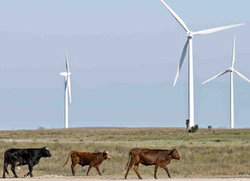
Philadelphia Inquirer | 17 May 2011
Erin Arvedlund
The world’s second-oldest profession–farming–is a hot investment
My column this week in the Philadelphia Inquirer takes a look at why Wall Street luminaries like GMO’s Jeremy Grantham hold a special place in their wallets for investing in farmland. And with rising prices on everyone’s mind, it turns out arable land is closely correlated as a hedge against inflation. Here’s a reprint below:
Yields on farmland can be quite good, and not just in crops. For investors, the opportunities are growing.
There is a scramble for farmland globally, and it turns out it is not just to grow food. Investors are discovering returns on farming land that rival those of the U.S. stock market.
Some Wall Street luminaries have long been fans of farmland as part of an investment portfolio. Why? The Standard & Poor’s 500-benchmark index’s average annual return was 11.8 percent between 1950-2008, while the return on farmland with capital appreciation and current yield was 11.6 percent.
“But the volatility of the S&P is about double that of farmland,” notes Shonda Warner, manager of Chess Ag Full Harvest Partners L.L.C., which manages the Full Harvest Agricultural Opportunities hedge funds that invest in farmland.
What makes up farmland’s returns? There are three components:
- Capital appreciation of the land itself.
- The current cash yield, from grown crops harvested every year.
- Assets such as livestock and seed sales, hunting rights, mineral rights, water rights, even wind rights.
Farmland prices in Pennsylvania between 2006 and 2010 have risen from an average of $4,380 per acre to $5,000 per acre.
There are ways to track the investment returns on farmland, but not as many vehicles for typical retail investors to actually wager their own money. However, more are coming.
For decades, investing in farmland was the province of insurance companies. They smartly viewed farmland as a highly correlated inflation hedge and diversification tool. Jeremy Grantham, who runs the billion-dollar GMO L.L.C. investment funds in Boston, recently said his personal “very long-term recommendations remain the same: Forestry and good agricultural land.”
Hancock Agricultural Investment Group (HAIG) is the largest institutional farmland manager in the United States, managing $1.2 billion in agricultural land for institutional investors, including public and corporate pension funds and Taft-Hartley plans for unions. HAIG’s farmland consists of 180,000 acres in the United States, Australia, and Canada. But HAIG’s minimum investment starts at $5 million.
CalPERS,the California Public Employees Retirement System, has long owned an investment in Premier Pacific Vineyards.
What about the rest of us? To start tracking the sector, check out the S&P GSCI Agricultural Index, the DJ-UBS Agriculture Sub-Index, or the JP Morgan Commodity Curve Agriculture Index.
For direct investors, American Farmland plans an IPO that would be a roll-up of grain farmers from around the American Midwest, in particular the Dakotas. Marketing director Todd Dyer says the future public company models its business plan after Waste Management, which transformed a highly fragmented industry into a large public corporation. Farmland will remain in demand, he says.
Investors might be surprised to find out that the top countries ranked by arable hectares (1 hectare equals 10,000 square meters) of land are the United States, India, China, Russia, and Brazil. But the developing countries in the group are grappling with exploding populations.
“More food will have to be grown in the next 50 years than in the past 10,000,” Dyer said.
Exchange-traded funds in agriculture exist but don’t trade very well or very often, warns Chess Ag’s Warner, who grew up a Nebraska farm girl and then worked as a futures trader for Goldman Sachs. “ETFs are popular, but the liquidity can go away quickly,” she said.
Among the exchange-traded vehicles is the Dow Jones-UBS Agriculture Subindex Total Returnfund that tracks an eponymous index. UBS Bloomberg Constant Maturity Commodity Index Livestock ETN seeks to track the price and performance yield of the UBS Bloomberg CMCI Livestock Total Return Index, a basket of livestock future contracts. Two food ETNs are available: The UBS Bloomberg CMCI Food Index tracks a basket of agriculture and livestock futures contracts, while theUBS Bloomberg CMCI Agriculture ETN tracks an agriculture index.
Mutual funds also are making a play on agriculture. John Lekas is portfolio manager at Leader Capital Corp., investors for the Leader Total Return Fund.
Lekas also sees a strong future for investing in farmland: “The United States has almost 3 acres of farmland per capita. By comparison, China only has about .23 acres per person. In 2009, the U.S. produced 39 percent of the world’s corn and shipped over 20 percent of its production overseas.”
Best of all, farmland’s value keeps up with inflation, while the returns are uncorrelated with stocks when the market tanks, Warner says. Farmland is a hard asset and right now, not heavily leveraged, like in the 1970s and early 1980s, when many American farmers borrowed to the hilt and went bust during the double-digit interest-rate period.
Erin Arvedlund is a finance reporter and resides in Philadelphia. Contact her at [email protected].












